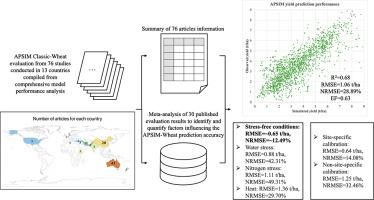Agricultural Systems ( IF 6.1 ) Pub Date : 2021-09-22 , DOI: 10.1016/j.agsy.2021.103278 Shirui Hao 1 , Dongryeol Ryu 1 , Andrew Western 1 , Eileen Perry 1, 2 , Heye Bogena 3 , Harrie Jan Hendricks Franssen 3

|
CONTEXT
Process-based crop models provide ways to predict crop growth, evaluate environmental impacts on crops, test various crop management options, and guide crop breeding. They can be used to explore options for mitigating climate change impacts when combined with climate projections and explore mitigation of environmental impacts of production. The Agricultural Production Systems SIMulator (APSIM) is a widely adopted crop model that offers modules for simulation of various crops, soil processes, climate, and grazing within a modelling system that enables robust addition of new components.
OBJECTIVE
This study uses APSIM Classic-Wheat as an example to examine yield prediction accuracy of biophysically based crop yield modelling and to analyse the factors influencing the model performance.
METHODS
We analysed yield prediction results of APSIM Classic-Wheat from 76 published studies across thirteen countries on four continents. In addition, a meta-database of modelled and observed yields from 30 studies was established and used to identify factors that influence yield prediction uncertainty.
RESULTS AND CONCLUSIONS
Our analysis indicates that, with site-specific calibration, APSIM predicts yield with a root mean squared error (RMSE) smaller than 1 t/ha and a normalised RMSE (NRMSE) of about 28%, across a wide range of environmental conditions for independent evaluation periods. The results show increasing errors in yield with limited modelling information and adverse environmental conditions. Using soil hydraulic parameters derived from site-specific measurements and/or tuning cultivar parameters improves yield prediction accuracy: RMSE decreases from 1.25 t/ha to 0.64 t/ha and NRMSE from 32% to 14%. Lower model accuracy was found where APSIM overestimates yield under high water deficit condition and when it underestimates yield under nitrogen limitation. APSIM severely over-predicts yield when some abiotic stresses such as heatwaves and frost affect the crop growth.
SIGNIFICANCE
This paper uses APSIM-Wheat as an example to provide perspectives on crop model yield prediction performance under different conditions covering a wide spectrum of management practices, and environments. The findings deepen the understanding of model uncertainty associated with different calibration processes or under various stressed conditions. The results also indicate the need to improve the model's predictive skill by filling functional gaps in the wheat simulations and by assimilating external observations (e.g., biomass information estimated by remote sensing) to adjust the model simulation for stressed crops.
中文翻译:

小麦产量预测模型的性能和影响性能的因素:综述和荟萃分析
语境
基于过程的作物模型提供了预测作物生长、评估环境对作物的影响、测试各种作物管理选项和指导作物育种的方法。当与气候预测相结合时,它们可用于探索减轻气候变化影响的选择,并探索减轻生产对环境的影响。农业生产系统模拟器 (APSIM) 是一种广泛采用的作物模型,它提供了用于在建模系统中模拟各种作物、土壤过程、气候和放牧的模块,从而能够稳健地添加新组件。
客观的
本研究以 APSIM Classic-Wheat 为例,检验基于生物物理的作物产量模型的产量预测准确性,并分析影响模型性能的因素。
方法
我们分析了来自四大洲 13 个国家的 76 项已发表研究的 APSIM Classic-Wheat 产量预测结果。此外,还建立了 30 项研究的建模和观察产量元数据库,用于确定影响产量预测不确定性的因素。
结果和结论
我们的分析表明,通过特定地点的校准,APSIM 预测产量的均方根误差 (RMSE) 小于 1 t/ha,归一化 RMSE (NRMSE) 约为 28%,适用于各种独立的环境条件。评估期。结果表明,在有限的建模信息和不利的环境条件下,产量误差越来越大。使用从特定地点测量得出的土壤水力参数和/或调整栽培品种参数可提高产量预测精度:RMSE 从 1.25 t/ha 降至 0.64 t/ha,NRMSE 从 32% 降至 14%。当 APSIM 高估高缺水条件下的产量和低估氮限制下的产量时,发现模型精度较低。
意义
本文以 APSIM-Wheat 为例,提供了不同条件下作物模型产量预测性能的观点,涵盖了广泛的管理实践和环境。这些发现加深了对与不同校准过程或在各种压力条件下相关的模型不确定性的理解。结果还表明需要通过填补小麦模拟中的功能空白和同化外部观测(例如,遥感估计的生物量信息)来调整模型模拟以适应受压作物,从而提高模型的预测能力。











































 京公网安备 11010802027423号
京公网安备 11010802027423号